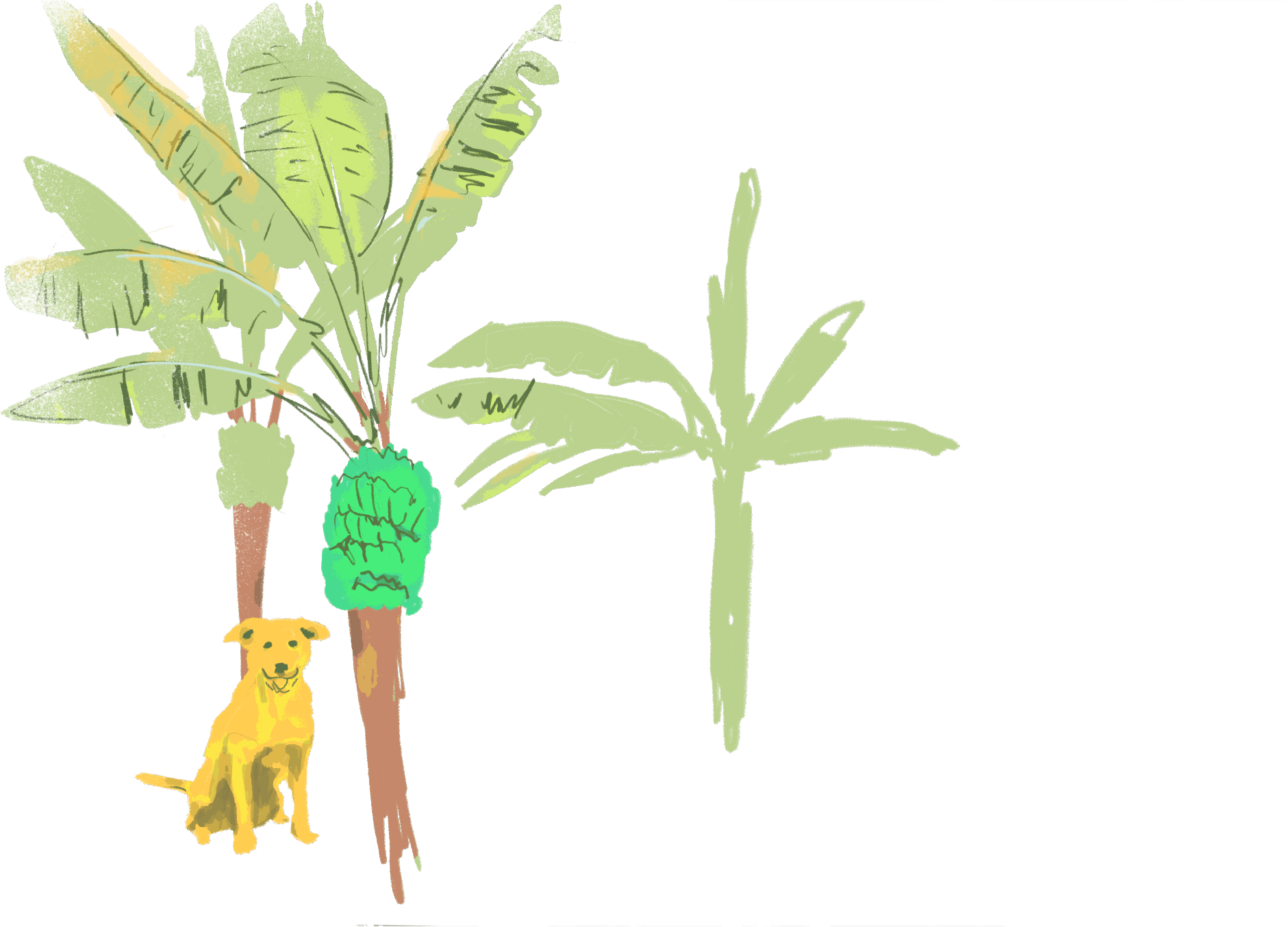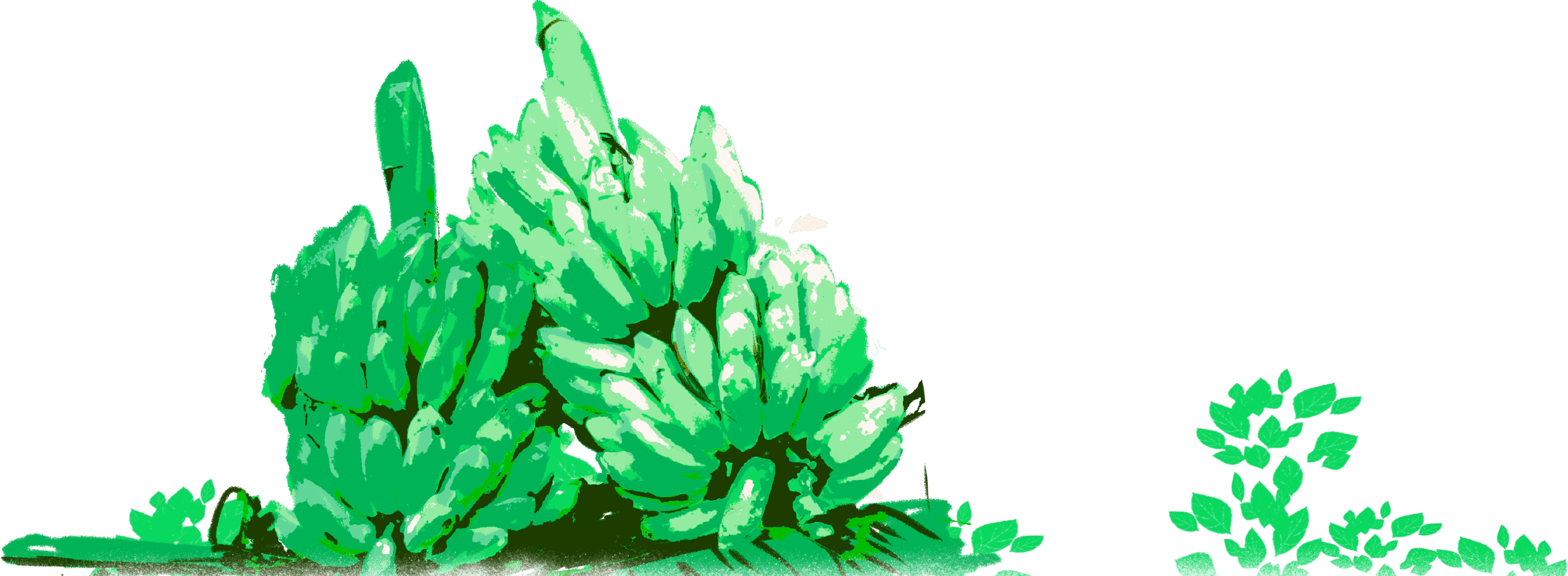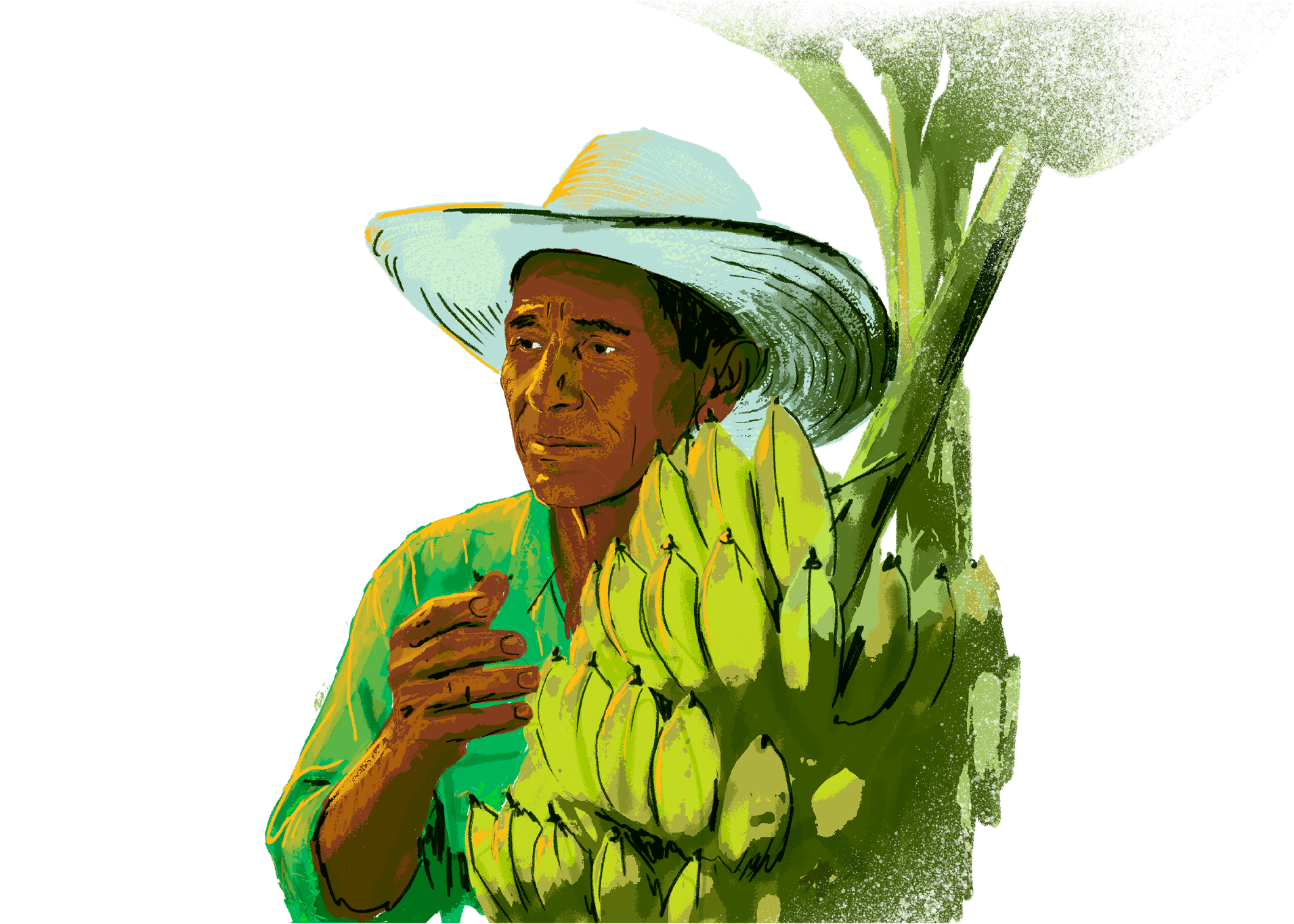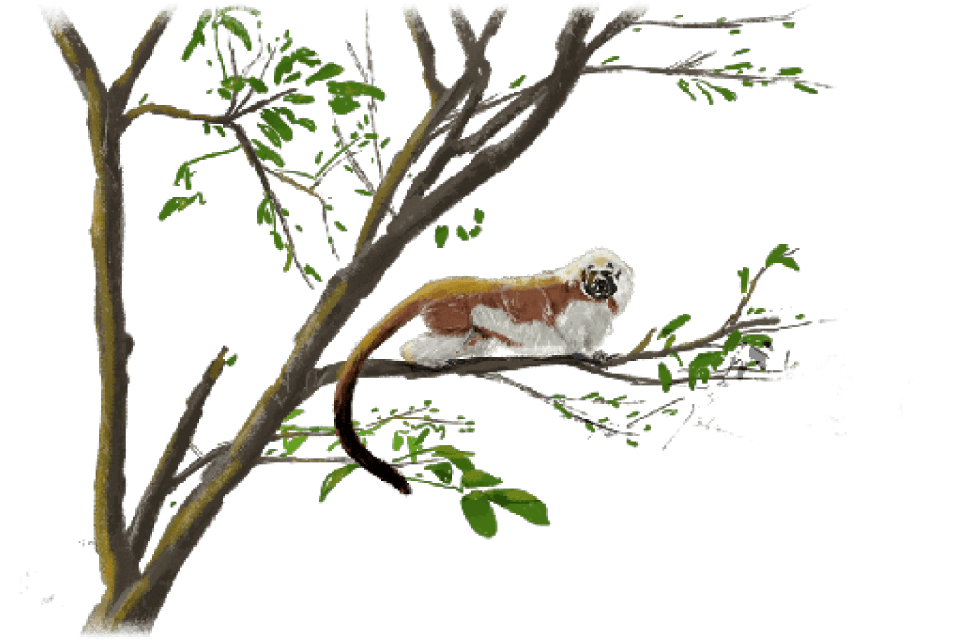The
Wealth of Care
An encounter with a farmer who took up a rifle in the name of several armed groups.
1
“War leaves poverty,” says this man who carried a rifle from 1987 to 2004. “War didn’t leave me anything good, only feelings of sadness.” He doesn’t want to give his name, or he doesn’t want it known beyond the people in the hamlet where he lives. He’s 55 and speaks in a tangled way, as if the words were hiding in his throat. “I think of things—children who died, innocent people. And I tell myself I shouldn’t have been part of that.” For the purposes of this story, he will be called D.
D arrived in Urabá in 1987 for the same reasons that had been bringing farmers from Chocó and Colombia’s Caribbean coast to the region for two decades: to find work in the booming banana agro industry. He came from a Córdoba town with Zenú heritage called San Andrés de Sotavento, where he was born and raised, and where people spent hours in rocking chairs on their doorsteps for lack of more productive work. A month after moving among the plantain farms in the rural districts of Turbo, D ended up joining the Popular Liberation Army (EPL). “They didn’t force me; I went because it caught my attention. I wanted to take part.” One ordinary morning, a guerrilla squad that often passed through told him he was the perfect age to go with them and fight for a better Colombia; that life in the group was good; that they didn’t pay but there was always food; that the reason for the struggle was “to make Colombia like Cuba.” D says other young people and boys from nearby farms had already gone off to the EPL, not dragged away but convinced they were taking a step toward a better life than they could make for themselves in the plantain fields. “Several people close to me were leaving; so I thought it over and left too.”
This guerrilla group was in its final stage as an armed actor. It had passed through the doctrines of foco warfare and protracted people’s war, had set up small fronts in rural areas as a first step toward surrounding the cities and launching a confrontation with the state’s armed forces, and—because it hadn’t managed to turn theory into successful practice—it had joined the main guerrilla groups of the era in what came to be called the Simón Bolívar Guerrilla Coordinator, to attack the state with greater firepower and to improve its position in peace negotiations.
“Several people close to me were leaving; so I thought it over and left too.”
3
The EPL’s recruitment in Urabá sought to swell its ranks to maintain territorial control in hamlets where it felt backed by the community. That would allow it to keep exerting dominant influence in Sintagro, the region’s largest union, and therefore in local political offices that, starting in 1988, would be filled by popular election.
D had never carried a weapon in his life, much less a rifle. He hadn’t even been a quarrelsome or defiant child or teenager. With the EPL’s training, D became the opposite: a man who kept calm and quiet but was capable of speaking hard, hitting, and shooting. “They trained us for war,” he says. “And you change: you transform, you get fierce, you feel brave. The commander would tell us, ‘We’re going to set an ambush; we need this many rifles and we have to get them by fighting.’ You’d go fight and get the rifles.”
D says the EPL had two kinds of squads: one infiltrated in the banana plantations, where fighters would drop their rifles and shed their fatigues to pass as plantation workers, then spend nights hidden in camps set up on the edge of the hamlets. The other squad was in the hills—in the Abibe mountain range, the natural border between Antioquia and Córdoba—wooded slopes turned into battlefields between the Coordinator and the security forces. D was part of the squad that moved around El 3, a township of Turbo, near a hamlet called Guadualito that people shortened to Guadalo. By then it was an area of plantain, not banana, a fully peasant zone where the land was divided into one or two hectare smallholdings, or plots of less than a hectare.
That’s why the relationship with the hamlet’s inhabitants was the EPL’s real mechanism of resistance. D recalls that the entrance road was in very poor condition but, in the end, still passable for vehicles. And yet the army almost never went in because it had grown weary of fruitless operations. D says that on the few occasions soldiers dared to enter the hamlet, the farmers would alert the guerrillas. “They watched out for us: if you had to leave camp, it was the people who told you whether you could or couldn’t because the army was around.”
The mutual trust between the community and the guerrillas was the result of subversive work. To begin with, many members of the squad were sons and relatives of local families—people with the same accent and the same deprivations—fighters who could be seen as the community’s own. The squad also acted paternal and protective in the face of poverty’s hardships. “We’d give them groceries,” D says. “If they were sick, we’d give them money for medicine and arrange transportation to the hospital.”
2
The EPL signed a peace agreement with the national government on February 15, 1991, and handed over its weapons and demobilized its men fifteen days later, on March 1. From then on, it created a political movement called Hope, Peace, and Freedom. It was an electoral strategy through which they hoped to compete for elected office against the traditional parties in the rest of the country and against the Patriotic Union, which was the dominant political force in Urabá. From one week to the next, the names of those who had been commanders and ideologues became the faces of candidates. The mid level commanders and rank and file fighters fared worse: they started becoming the names of demobilized men who began to be killed by friendly fire. “They started killing us,” D says. “They killed Hope, Peace, and Freedom.”
Of the 2,200 guerrillas who had formed the EPL, a faction of about sixty men rejected the peace agreement and remained as a dissident group under Francisco Caraballo, one of the EPL’s founders, a radical communist—or “a convinced communist,” as he presented himself to the courts after his capture years later. These dissidents argued that every peace agreement guerrillas had reached with the government throughout this country’s history ended up being “a surrender” or “a set up by the bourgeois state to eliminate revolutionary leaders who, at some point, had played into the regime’s hands.” Caraballo reaffirmed war as “the true path toward a socialist government” and warned that there was no longer room in the organization for those lined up behind the peace process, whom he called “sellouts.” In other words, Caraballo considered that he and his men, even as a minority, remained the Popular Liberation Army, and that the commanders and militants in the negotiation were traitors.
In a matter of days, a violence of auto cannibalism began—the Caraballo group killing their former comrades—and by the end of 1991 there were already around twenty homicides of Hope, Peace, and Freedom militants—“the hopefuls,” people called them. Within weeks the FARC found reasons to shelter or absorb Caraballo’s dissidents: that some of the hopefuls had alliances with the “class enemies”—cattle ranchers and banana entrepreneurs; that others had joined the intelligence agencies and the security forces; and that still others had been co opted by the Castaño family’s paramilitaries. This absorption gave rise to a death squad called the Bernardo Franco Military Front, whose exclusive purpose was to attack people tied to Hope, Peace, and Freedom, regardless of the degree of political involvement—from sympathizers and activists to militants and union leaders.
“Everything got worse,” D says. “The FARC disagreed with our having surrendered and gone to work with the government. That’s what they said, and that’s why they were killing us.” One by one in targeted killings, and by the dozen in massacres. The figures say that between 1991 and the end of 1996, the FARC committed eighteen massacres against the hopefuls—more than two thousand attacks in all, including threats, murders, displacement, and land theft. “The FARC killed a lot of our people. At least four a day. All former combatants. All from Hope, Peace, and Freedom. You could be at home and the FARC would come in and kill you right there. And if they couldn’t find the one they were after, they killed everyone in the house,” D says.
At the beginning of 1992, one year after signing peace with the government, a sector of the hopefuls returned to arms under the pretext of self defense. They called themselves the People’s Commandos and fell under the command of Rafael García, alias El Viejo, one of the EPL’s most veteran fighters who, after demobilization, coordinated the reintegration office in Apartadó. After the kidnapping of three hopefuls on March 5, El Viejo met with several men who had been mid level EPL commanders; they told each other they wouldn’t let themselves be killed, that it was better to die armed than to die on their knees, and they dug up weapons they had stashed after demobilization. “Those were weapons we didn’t turn in at the signing of the peace agreement,” D explains. “Because of everything that had happened with the M 19—that they had killed Carlos Pizarro and so many others—we didn’t fully trust the government. And it turned out it was the FARC who attacked us.”
The People’s Commandos ended up as five squads, or five companies. “There were just a few of us, around two hundred.” Three of the five were on the outskirts of Turbo—San Jorge, the road to Necoclí, and Nueva Colonia. A fourth was in the municipal seat of Apartadó and the fifth at the Zungo pier in Carepa. “The commander called me—Mataperro, also known as Domingo,” D adds. This leader was named Benito Ricardo Betín Muñoz and commanded the company in the San Jorge township. “With Mataperro we started hitting the Patriotic Union, because it came from the FARC.”
Like every illegal armed group Colombia has had, the People’s Commandos didn’t remain in a state of self defense; they didn’t stay put in their rear guard positions waiting to repel enemy incursions. They went on the offensive and, therefore, began recruiting. They carried out high profile massacres such as the one at the Los Cativos farm on the outskirts of Turbo in December 1993, when they made twelve banana workers lie face down and shot them in the head with rifles—men whose political past was tied to the Colombian Communist Party. “Workers from Hope, Peace, and Freedom themselves would tell us who was who on the plantations: ‘That guy works with the FARC, or he’s from the UP.’ We’d go find him, grab him, and take him away. And they would thank us.”
D adds that war was tit for tat. He remembers surviving an attack in 1995. The FARC entered the Las Camelias settlement, in the El 3 district of Turbo, to kill members of the People’s Commandos. D had a house there—a peasant shack of sticks and dirt—and he was inside when he heard gunfire and explosions. He ran to grab his rifle and, in the exchange, one of his companions threw a grenade. The FARC replied and D felt his house explode and collapse on top of him. There was fire and he lost his sense of space and let go of the rifle. “I got out however I could, wounded,” he says. “They burned my house, but none of us died. We were injured, yes. But there were FARC dead.”
The name People’s Commandos lasted six years, D says. That is, they were heard of until 1998, even though from late 1994 and through 1995 they were becoming the manpower of the nascent Peasant Self Defense Forces of Córdoba and Urabá, the ACCU—the paramilitary group of the Castaño brothers.
“They burned my house, but none of us died. We were injured, yes. But there were FARC dead.”
3
The ACCU emerged in the department of Córdoba, and their expansion into Urabá was only possible thanks to the men of the People’s Commandos, who served as their guides in unfamiliar terrain. The relationship between the two groups was born of having a common enemy, the FARC. But since the Castaño clan had far greater firepower—more men and more weapons—and already enjoyed the backing of high ranking elements of the security forces as well as people linked to the region’s industries, including the banana sector, it was taken for granted that the ACCU would absorb the People’s Commandos. It was similar to what had happened with the FARC and Caraballo’s dissidents.
D says his superiors told him that “the self defense forces had called in the Commandos,” that he should store the rifles and stay put until they came for him in person. “They told me my father was coming in. And I wondered, Who is my father? And they said: Carlos Castaño.” As the highest ranking commander among the Commandos in his hamlet, D received the weapons and stored them until further orders. They handed him twenty eight rifles, the same number as fighters, and reminded him: “They’re coming for you.” Days later, an ACCU man known as Estopín went to Las Camelias and gathered the twenty eight Commandos to tell them to join Carlos Castaño’s troops—that the real war was about to begin. D says all twenty eight accepted because, by then, the FARC were winning the territorial war. “They were wiping us out and were going to end up taking over the area where we were.” D says other farmers from the hamlet who had never carried a rifle or taken an interest in joining armed groups also asked to enter the ACCU. Perhaps it was fear joined to the desire for revenge against guerrilla violence, or perhaps it was the Castaño clan’s reputation that preceded them: imposing themselves above all else, killing mercilessly and razing hamlets, presenting themselves as a force no one would stop.
D, the rest of the Commandos, and the newcomers were taken to a training farm. “They trained us for war, again,” he says, recalling that the EPL had already put him through something like that. “But it was a different kind of training. The one training us wasn’t Colombian; I think he was from Israel. And he gave instructions from a car.” D says they didn’t force him to complete the training, because everyone knew he was an experienced fighter.
With the ACCU reinforced by the People’s Commandos, a very bloody phase of violence began in Urabá. Massacres multiplied and became the measure of exchange: for a FARC massacre against banana workers who had come from the EPL’s demobilization, there would be an ACCU massacre against banana workers from the Patriotic Union or the Communist Party. Social leaders fell, union leaders, politicians campaigning, politicians in office. There were forced displacements and land grabs. The paramilitary commanders took control of the roads and the places boats departed to seize the drug trafficking routes. And in the mountain areas they supported some army operations. “When Carlos Castaño’s self defense forces came in, there was a lot of violence. Many deaths. Civilians. Guerrillas. People who knew nothing about war. Children,” D says.
When asked about his specific participation in crimes against humanity such as a massacre or a disappearance, D tries to lay out his defense: he says he belonged to a group of paramilitaries that fought the guerrillas in combat zones, such as the northern reaches of the Paramillo highlands and the Abibe range. And that the massacres and crimes against the civilian population were carried out by another paramilitary faction charged with exterminating political leaders, union officials, and party militants.
D entered the peace process that the government of Álvaro Uribe Vélez held with the United Self Defense Forces of Colombia (AUC). As a member of the Banana Bloc and a fighter under Hebert Veloza, alias HH—“El Mono Veloza,” as D calls him—D laid down his rifle and signed demobilization in 2004. It was the end of seventeen years given over to war.
After fulfilling the requirements of transitional justice, D focused on turning his plot in the Las Camelias hamlet into a productive plantain farm—the plot had belonged to an uncle and is now his. In other words, the very reason he had left San Andrés de Sotavento in 1987. As if he had postponed his plans for a farmer’s life by living through the trials of a man of war. “Going to the EPL was my fault, no one else’s,” he says. “Changing the country by force of rifles… you can’t do it.”
With the money the government deposited each month because he had demobilized, he set up the crop, and after the first harvest he began paying for improvements. On the one hectare he owns he managed to plant nine hundred plantain trees that produce between fifteen and twenty 24.5 kilogram boxes a week. It gives him a modest income: a little under five hundred thousand pesos after covering expenses, including the wages of a helper. “If I had more land, I’d improve my income and give more people work.”
D is the father of two children over twenty who live in the hamlet, though not with him. One of his frustrations is that he has no house—“I have land, but I don’t have a house.” D lives in the hut he built as the work center for the crop. “I’ve never had the money to build a house,” he says. No police patrol or army unit ever comes to the hamlet, even though the presence of the Gulf Clan’s men is neither small nor sporadic: every day they control the entry of outsiders through a checkpoint on the access road. “I feel safe where I am because they don’t mess with you,” he says. “And my past hasn’t intruded on my present. That’s because I was good to the community, because I treated people well. If someone asked me today, I’d tell them not to join armed groups—not to give themselves to violence.”



